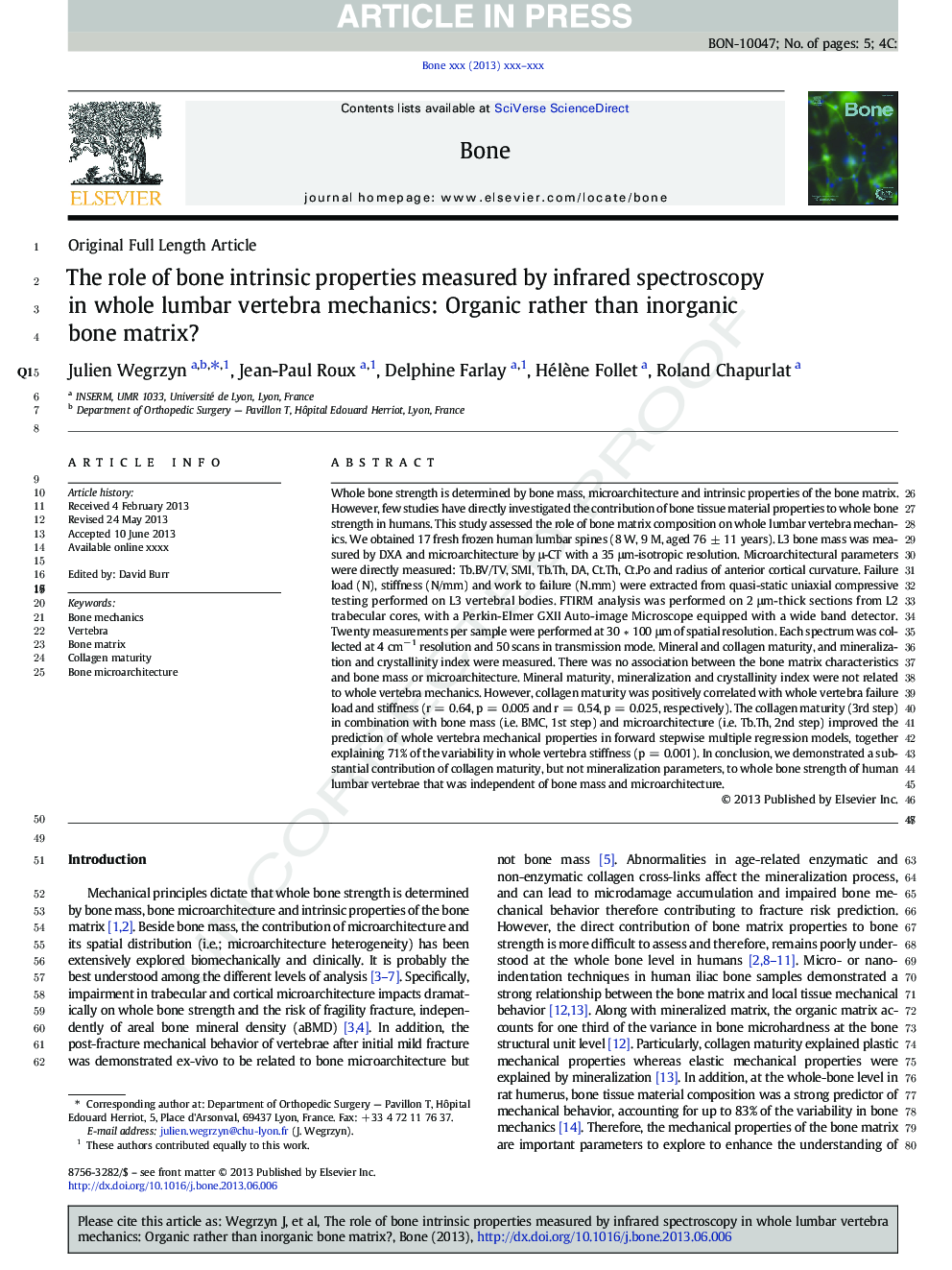| کد مقاله | کد نشریه | سال انتشار | مقاله انگلیسی | نسخه تمام متن |
|---|---|---|---|---|
| 5890939 | 1153262 | 2013 | 5 صفحه PDF | دانلود رایگان |
عنوان انگلیسی مقاله ISI
The role of bone intrinsic properties measured by infrared spectroscopy in whole lumbar vertebra mechanics: Organic rather than inorganic bone matrix?
ترجمه فارسی عنوان
نقش خواص ذاتی استخوان که توسط طیف سنجی مادون قرمز در کل مکانیک مهره کمری اندازه گیری می شود: ارگانیک به جای ماتریکس غیر معدنی استخوان؟
دانلود مقاله + سفارش ترجمه
دانلود مقاله ISI انگلیسی
رایگان برای ایرانیان
کلمات کلیدی
مکانیک استخوان، مهره ماتریکس استخوان، بلوغ کلاژن، میکروسکوپیک استخوان،
موضوعات مرتبط
علوم زیستی و بیوفناوری
بیوشیمی، ژنتیک و زیست شناسی مولکولی
زیست شناسی تکاملی
چکیده انگلیسی
Whole bone strength is determined by bone mass, microarchitecture and intrinsic properties of the bone matrix. However, few studies have directly investigated the contribution of bone tissue material properties to whole bone strength in humans. This study assessed the role of bone matrix composition on whole lumbar vertebra mechanics. We obtained 17 fresh frozen human lumbar spines (8 W, 9 M, aged 76 ± 11 years). L3 bone mass was measured by DXA and microarchitecture by μ-CT with a 35 μm-isotropic resolution. Microarchitectural parameters were directly measured: Tb.BV/TV, SMI, Tb.Th, DA, Ct.Th, Ct.Po and radius of anterior cortical curvature. Failure load (N), stiffness (N/mm) and work to failure (N.mm) were extracted from quasi-static uniaxial compressive testing performed on L3 vertebral bodies. FTIRM analysis was performed on 2 μm-thick sections from L2 trabecular cores, with a Perkin-Elmer GXII Auto-image Microscope equipped with a wide band detector. Twenty measurements per sample were performed at 30 â 100 μm of spatial resolution. Each spectrum was collected at 4 cmâ 1 resolution and 50 scans in transmission mode. Mineral and collagen maturity, and mineralization and crystallinity index were measured. There was no association between the bone matrix characteristics and bone mass or microarchitecture. Mineral maturity, mineralization and crystallinity index were not related to whole vertebra mechanics. However, collagen maturity was positively correlated with whole vertebra failure load and stiffness (r = 0.64, p = 0.005 and r = 0.54, p = 0.025, respectively). The collagen maturity (3rd step) in combination with bone mass (i.e. BMC, 1st step) and microarchitecture (i.e. Tb.Th, 2nd step) improved the prediction of whole vertebra mechanical properties in forward stepwise multiple regression models, together explaining 71% of the variability in whole vertebra stiffness (p = 0.001). In conclusion, we demonstrated a substantial contribution of collagen maturity, but not mineralization parameters, to whole bone strength of human lumbar vertebrae that was independent of bone mass and microarchitecture.
ناشر
Database: Elsevier - ScienceDirect (ساینس دایرکت)
Journal: Bone - Volume 56, Issue 2, October 2013, Pages 229-233
Journal: Bone - Volume 56, Issue 2, October 2013, Pages 229-233
نویسندگان
Julien Wegrzyn, Jean-Paul Roux, Delphine Farlay, Hélène Follet, Roland Chapurlat,
